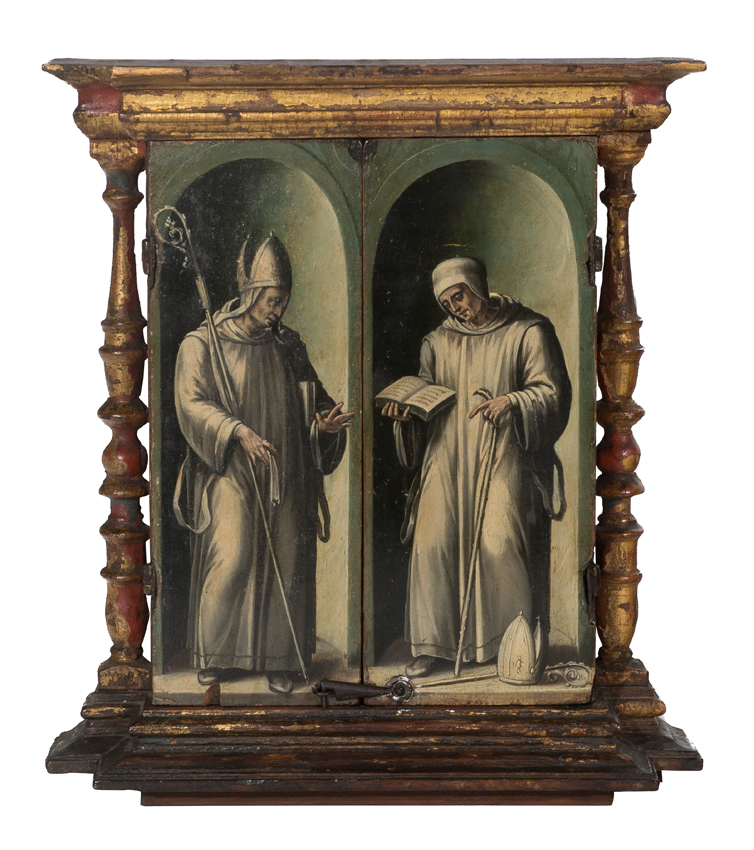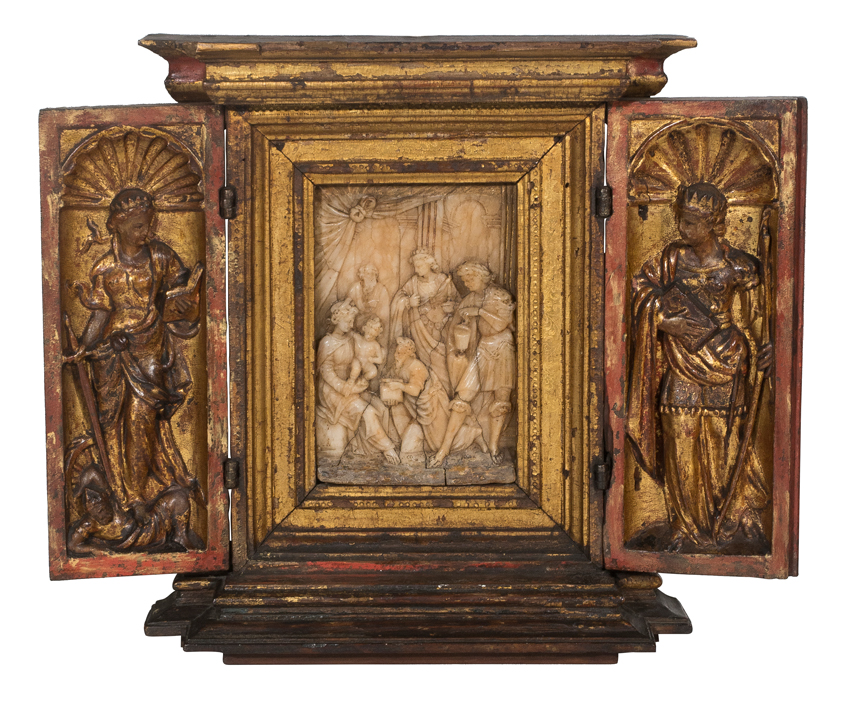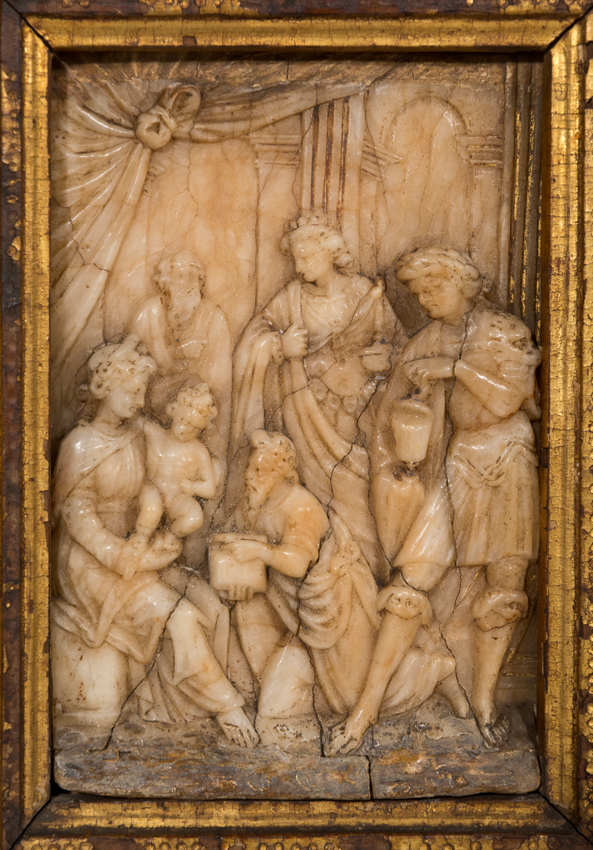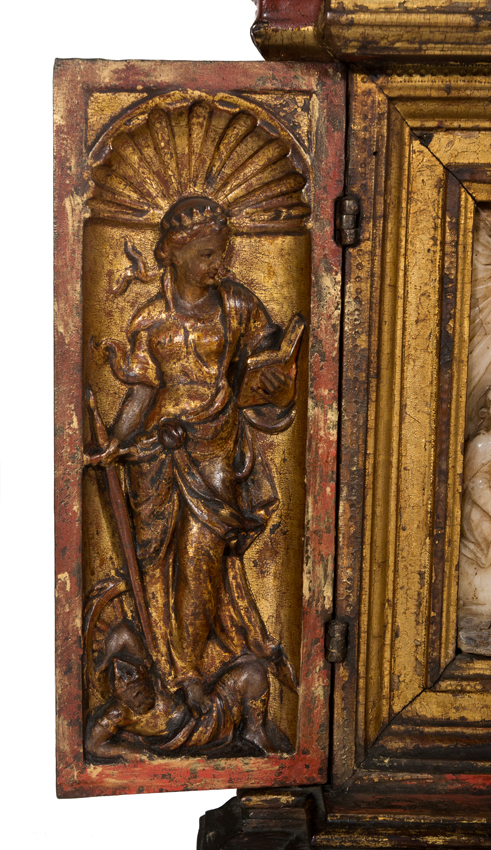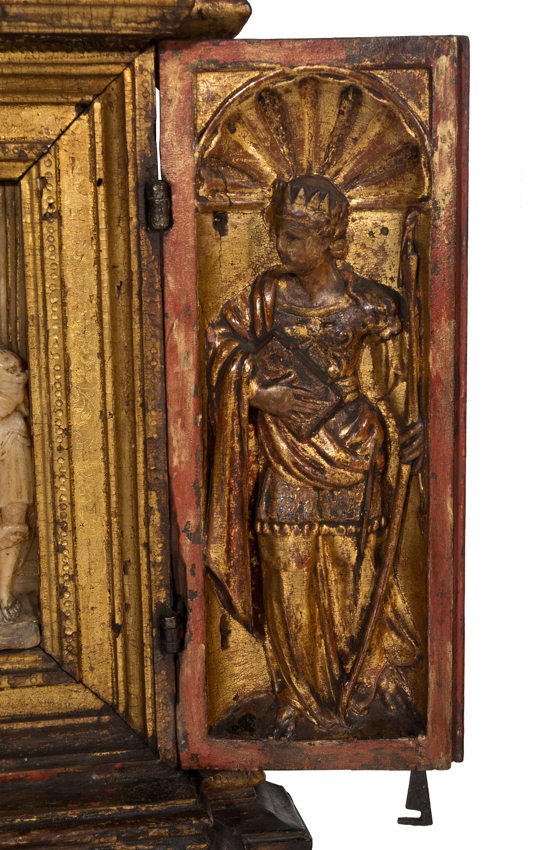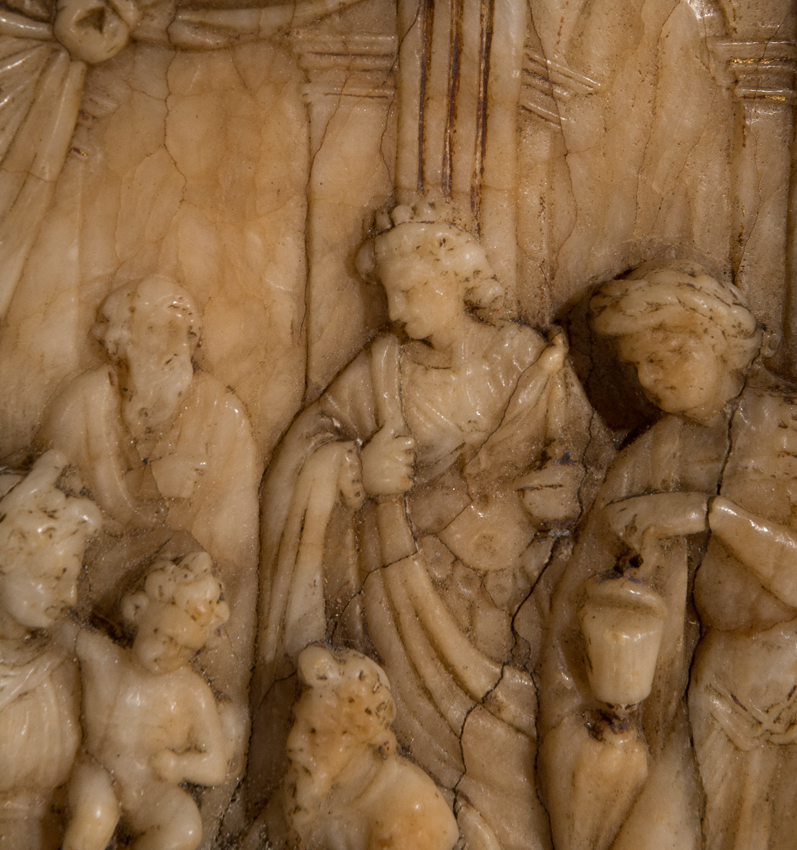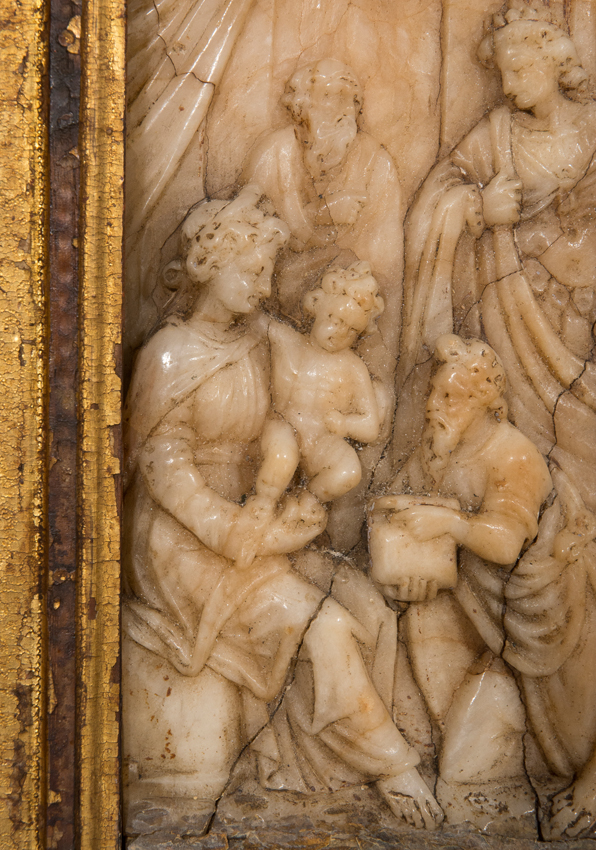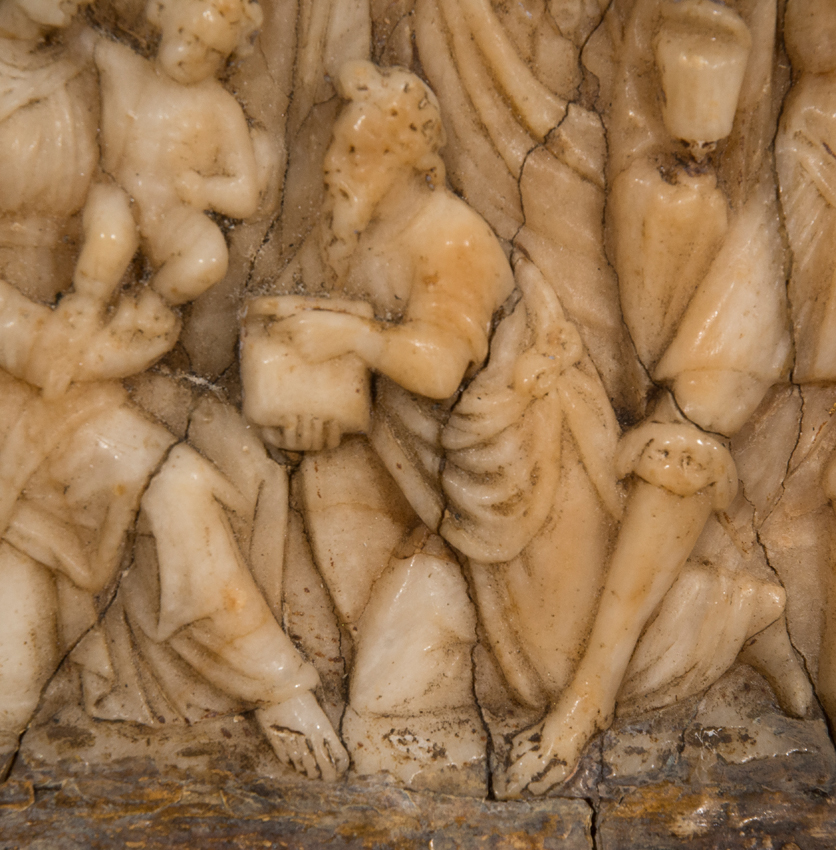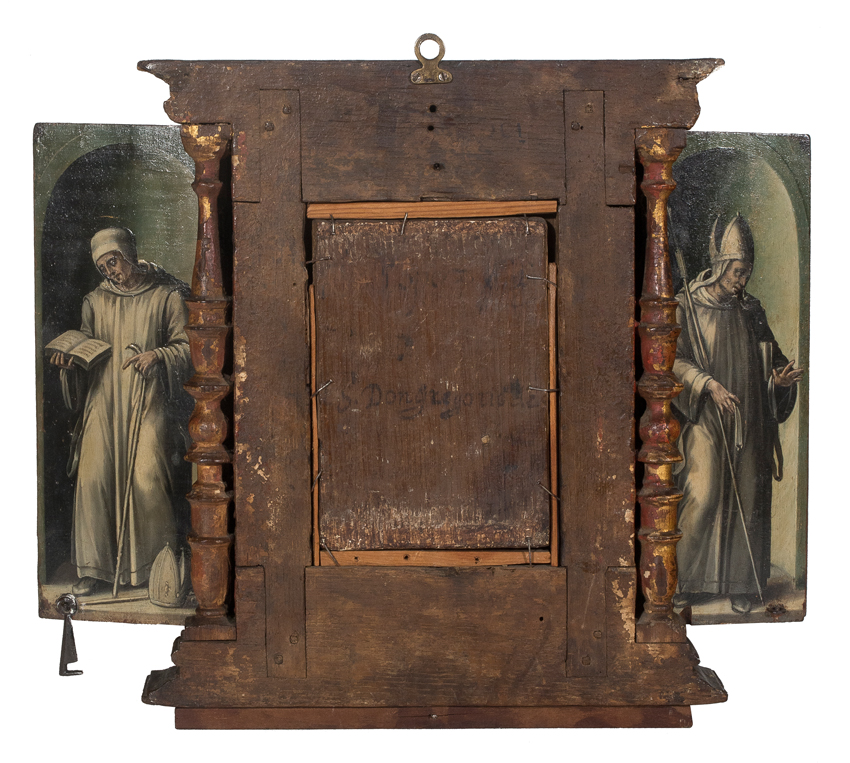9
"Portable Altar of the Epiphany". Carved, polychromed and gilded wood and alabaster. Castile. Second
In Millésime 23
"Portable Altar of the Epiphany". Carved, polychromed and gilded wood and alabaster. Castile. Second quarter of the 16th century.
Measurements: Closed: 32 x 28 x 7.5 cm.; open: 32 x 38.5 x 7.5 cm.; alabaster: 15.5 x 10.5 cm.; doors: 24 x 9.5 cm each.
This small portable altar is an exquisite Renaissance piece from the mid-16th century in which polychromed wood and alabaster, sculpture and painting blend harmoniously. The little altar is actually a triptych: when it is closed, it shows two delicate grisaille paintings on its doors, as is usual in this type of piece; When opened, those same sections display two reliefs of saints while the central piece is made up of a very interesting alabaster sculpture of the Epiphany or Adoration of the Magi, which could be the work of a Mechelen workshop. The framework that contains all these artistic elements is very simple, without any ornament or decoration apart from the two elegant balustraded columns that flank the altar and frame the double painting that is shown when it is closed. This type of small or larger altars corresponds to a clear devotional typology which was made to satisfy the need of certain people with sufficient purchasing power to own a piece of this kind. It would have been placed in a small chapel or oratory in their home. Beginning with the paintings on the exterior, which, as we have already pointed out, are grisaille, we can see that a beardless saint has been portrayed on each of the doors within a micro-architecture consisting of a niche with a semicircular finish that serves to give the sensation of depth to the scene and corporeality to the saints. Between both niches, in the upper part, there seems to be a kind of oculus or clypeus. On the left door there is a bishop saint dressed in the pontifical robes associated to his status, mitre and crosier, while under his left armpit he holds a closed book. With his right hand he seems to be holding a ribbon. On the right door is a saint who is the complete opposite of his companion, since if he seems to have decided to renounce the role of bishop, denoted by the staff and mitre which appear lying on the ground. He wears a tunic and a kind of cap that hides his ears. Both saints have been painted in detail, showing small, angular facial features and pensive countenances. The hands, which are very delicate, are expressive and the fingers appear clenched. When the doors are opened we find the central motif of the triptych altar, a delicate alabaster relief of the Epiphany that is carved in different gradations to try to give depth to the scene. This is also helped by the bas-relief architecture in the background that consists of pillars that support semicircular arches, partly covered by a canopy tied with a bow. This type of alabaster sculpture enjoyed great popularity during the 16th century. As was customary even in the 16th century, Saint Joseph has been portrayed as an old man slightly removed from the main scene, so much so that a very undefined bas-relief has also been used for him. The central group is carved in high relief with some parts completely free-standing. It is made up of the Virgin Mary seated with the Child, with a classicist appearance reminiscent of Roman matrons, and before them are the three Wise Men: Melchior, with a bearded appearance, bending down to offer Jesus the gold while standing behind him, young and beardless Caspar and Balthasar wait to offer the incense and myrrh. The garments are luxurious and feature shallow but gentle, curved folds. Balthasar's attire is especially noteworthy since the author has endowed him with a turban, instead of a crown, as well as some kind of animal heads on his shoulders and knees. Finally, the inner part of the doors shows two saints who held the status of queens, as indicated by the fact that their heads are crowned. As was the case with the saints on the outside, the saints are also found inside micro-architecture, although on this occasion the niches are topped by shells, a typically Renaissance detail. Both wear luxurious dresses that are very tight on the torso, giving them a remarkable elegance, to which the postures in which they have been conceived also contribute. The saint on the left door, who carries an open book in her left hand, is Saint Catherine of Alexandria, as indicated by the presence of her most characteristic attributes: the sword and the spiked wheel, instruments of her successive martyrdom, and the body of a defeated man at her feet who must be the Emperor Maxentius, her persecutor. On the other door on the right we find another saint with the same formal characteristics, although her clothing has changed somewhat. In her left hand she carries a closed book while in her left she holds an a bow and arrow. We do not know who it may be, perhaps due to the rarity of these attributes it may be a saint of local or regional devotion which, in turn, would indicate the place for which this precious portable altar was carved. As a curiosity, on the back of the altarpiece there are a series of inscriptions, some illegible and others legible, such as the one that says ““S.DonGregorio” and “Lopez”, which perhaps alludes to the owner for whom this exquisite piece was made.
We would like to thank Mr. Javier Baladrón, PhD in Art History, for identifying and cataloguing this piece.
"Portable Altar of the Epiphany". Carved, polychromed and gilded wood and alabaster. Castile. Second quarter of the 16th century.
Measurements: Closed: 32 x 28 x 7.5 cm.; open: 32 x 38.5 x 7.5 cm.; alabaster: 15.5 x 10.5 cm.; doors: 24 x 9.5 cm each.
This small portable altar is an exquisite Renaissance piece from the mid-16th century in which polychromed wood and alabaster, sculpture and painting blend harmoniously. The little altar is actually a triptych: when it is closed, it shows two delicate grisaille paintings on its doors, as is usual in this type of piece; When opened, those same sections display two reliefs of saints while the central piece is made up of a very interesting alabaster sculpture of the Epiphany or Adoration of the Magi, which could be the work of a Mechelen workshop. The framework that contains all these artistic elements is very simple, without any ornament or decoration apart from the two elegant balustraded columns that flank the altar and frame the double painting that is shown when it is closed. This type of small or larger altars corresponds to a clear devotional typology which was made to satisfy the need of certain people with sufficient purchasing power to own a piece of this kind. It would have been placed in a small chapel or oratory in their home. Beginning with the paintings on the exterior, which, as we have already pointed out, are grisaille, we can see that a beardless saint has been portrayed on each of the doors within a micro-architecture consisting of a niche with a semicircular finish that serves to give the sensation of depth to the scene and corporeality to the saints. Between both niches, in the upper part, there seems to be a kind of oculus or clypeus. On the left door there is a bishop saint dressed in the pontifical robes associated to his status, mitre and crosier, while under his left armpit he holds a closed book. With his right hand he seems to be holding a ribbon. On the right door is a saint who is the complete opposite of his companion, since if he seems to have decided to renounce the role of bishop, denoted by the staff and mitre which appear lying on the ground. He wears a tunic and a kind of cap that hides his ears. Both saints have been painted in detail, showing small, angular facial features and pensive countenances. The hands, which are very delicate, are expressive and the fingers appear clenched. When the doors are opened we find the central motif of the triptych altar, a delicate alabaster relief of the Epiphany that is carved in different gradations to try to give depth to the scene. This is also helped by the bas-relief architecture in the background that consists of pillars that support semicircular arches, partly covered by a canopy tied with a bow. This type of alabaster sculpture enjoyed great popularity during the 16th century. As was customary even in the 16th century, Saint Joseph has been portrayed as an old man slightly removed from the main scene, so much so that a very undefined bas-relief has also been used for him. The central group is carved in high relief with some parts completely free-standing. It is made up of the Virgin Mary seated with the Child, with a classicist appearance reminiscent of Roman matrons, and before them are the three Wise Men: Melchior, with a bearded appearance, bending down to offer Jesus the gold while standing behind him, young and beardless Caspar and Balthasar wait to offer the incense and myrrh. The garments are luxurious and feature shallow but gentle, curved folds. Balthasar's attire is especially noteworthy since the author has endowed him with a turban, instead of a crown, as well as some kind of animal heads on his shoulders and knees. Finally, the inner part of the doors shows two saints who held the status of queens, as indicated by the fact that their heads are crowned. As was the case with the saints on the outside, the saints are also found inside micro-architecture, although on this occasion the niches are topped by shells, a typically Renaissance detail. Both wear luxurious dresses that are very tight on the torso, giving them a remarkable elegance, to which the postures in which they have been conceived also contribute. The saint on the left door, who carries an open book in her left hand, is Saint Catherine of Alexandria, as indicated by the presence of her most characteristic attributes: the sword and the spiked wheel, instruments of her successive martyrdom, and the body of a defeated man at her feet who must be the Emperor Maxentius, her persecutor. On the other door on the right we find another saint with the same formal characteristics, although her clothing has changed somewhat. In her left hand she carries a closed book while in her left she holds an a bow and arrow. We do not know who it may be, perhaps due to the rarity of these attributes it may be a saint of local or regional devotion which, in turn, would indicate the place for which this precious portable altar was carved. As a curiosity, on the back of the altarpiece there are a series of inscriptions, some illegible and others legible, such as the one that says ““S.DonGregorio” and “Lopez”, which perhaps alludes to the owner for whom this exquisite piece was made.
We would like to thank Mr. Javier Baladrón, PhD in Art History, for identifying and cataloguing this piece.
Millésime 23
Sale Date(s)
Venue Address
General delivery information available from the auctioneer
The purchase price includes the delivery of the lots in the venue of the auction. Transporting to other destinations is at the own risk of the client. The customer must contact "LST", to give the corresponding instructions for such transporting. "LST" is not responsible for the packaging or any accident incurred during transportation.
Important Information
Millésime 2023. Paintings, sculptures and works of Art from 13th to 20th Century. 61 important lots of European and Viceregal Art.
A pair of castas paintings Attributed to Ramón Torres (active in Mexico, 1770 - 1790), A Divine Shepherdess by Miguel Cabrera (Antequera de Oaxaca, Mexico, 1715 / 1720 - Mexico, 1768) an Imposing pair of angels from Viceroyalty of Peru. 17th - 18th century, a 14th century Calvary from Byzantine or Venetian School, or the great collection of 16th century flemish and italian oil on copper, are just few examples.
Terms & Conditions
CONDITIONS OF THE AUCTION:
I. REGISTRATION. To bid in the room customers must register at the beginning, filling out a form and picking a number that will identify them during the auction. Customers may be required to register in bank references or other guarantee system and if they do not prove the solvency "LST" will not accept bids and award the auction.
II. WRITTEN BIDS. "LST" will accept written bids, which will be formalized in the form provided by the room until the day before the auction. In such auctions, the room will bid in name of the client until the maximum stated in the offer and always at the lowest possible price. If there are two or more bids for the same amount, the one placed first will have the priority. Written bids received in advance, will have priority on the day of the auction.
III. TELEPHONE BIDS. "LST" will allow telephone bids, if interested people contact "LST" days before the auction providing personal data, ID card and the phone number which will be used by the staff of "LST" to call at the time of the auction. The buyer, within all the legal rights is making an offer for the asking price, when applies for telephone bid. "LST" will not take responsibility for any technical defects beyond its control, which may prevent to contact successfully the bidder during the auction.
IV. AUCTIONEER. The auction will be conducted by an auctioneer, director of the auction will be judge and arbitrator of it with full authority in its development, will award the lots to the highest bidder and is able to settle any controversy concerning lots sale, reject bids, divide lots or group them and remover objects from the room. Will be able to, if it is deemed suitable, not accept bids on the auction. His decision will be unappealable.
V. SALE OF LOTS. The lots are awarded to the highest bidder. Once the auctioneer blows the hammer, the buyer becomes responsible of the lot purchased, exempting "LST" of liability to for any damage and / or accidents that may occur. No refunds of lots.
VI. STARTING PRICE. The amount shown in the catalogue as the starting price for each lot will be, as a rule, the minimum selling price, except for exceptional cases where a reservation may be agreed upon with the seller or it set discretionary by the room.
VII. SCALE OF BIDS. The bids are set according to the following scale:
From 50.-€ to 200.-€…………………………………………..at 10.-€
From 200.-€ to 500.-€…………………………………… …25 in 25.-€
From 500.-€ to 1.000.-€………………………………..…..….50 in 50.-€
From 1.000.-€ to 2.000.-€………………………………..…100 in 100.-€
From 2.000.-€ to 5.000.-€……………………………….….250 in 250.-€
From 5.000.-€ to 10.000.-€…………………………………500 in 500.-€
From 10.000.-€ to 20.000.-€……………………………1.000 in 1.000.-€
From 20.000.-€ to 50.000.-€……………………………2.500 in 2.500.-€
From 50.000.-€ to 100.000.-€…………………………..5.000 in 5.000.-€
From 100.000.-€ to 100.000.-€………………………10.000 in 10.000.-€
From 200.000.-€ to 200.000.-€………………………25.000 in 25.000.-€
From 500.000.-€ to 500.000.-€………………………50.000 in 50.000.-€
VIII. RIGHT OF ADMISION. "LST" reserves the right to admission to the auction room and to reject, at its judgment, any purchase order, from clients whose solvency is not duly proved as well as not to sale auctions.
IX. SALE PRICES. The successful bidder of one or more lots must pay "LST" the final sale price achieves at auction, plus the 22 % plus 21% VAT on the commission, at total 26,62 % on Hammer Price.
X. CATALOG DATA. The catalogue data are obtained in order to careful research and advice, however, any responsibility is afforded about its accuracy. The lots will be auctioned in the state in which they are, not accepting any claims in restorations, breakage, damage, imperfections and, even description or numbering mistakes in the catalogue, in case of it, being the burden of the buyers to make sure before the auction that the description matches with their personal opinion about respective lot. The exhibition of the lots is intended to allow a perfect review and study of them.
XI. PAYMENT AND REMOVAL OF LOTS. Payment and removal of the lots will be held no later than five days following the auction. After this period expire without having the buyer removed the lot or lots purchases, it will accrue an expense of custody of 6 euros per day on each lot.
15 days after the auction without having the buyer paid and removes the sold lots, "LST" will inform the seller and there will begin judicial proceeding in order to obtain payment. The delay in payment by the purchaser of his/her sold lots will carry an interest increase at a rate of 1,5% per month.
XII. DELIVERY OF LOTS. The purchase price includes the delivery of the lots in the venue of the auction. Transporting to other destinations is at the own risk of the client. The customer must contact "LST", to give the corresponding instructions for such transporting. "LST" is not responsible for the packaging or any accident incurred during transportation.
XIII. RIGHT OF FIRT REFUSAL AND REPURCHASE. "LST" in order to article 38 of "Ley 16/1985 de 25 Junio del Patrimonio Histórico Español" (BOE. 155 June 29, 1985), will notify in advance to the Ministry of Culture, the content of their catalogues. Concerning the lots subject to the legislation referred to in the preceding paragraph, the Administration may exercise the rights of first refusal and repurchase according to the law. "LST" will watch over the protection of Artistic, Historical and Bibliographical Heritage of Spain. For customers out of European Community, a tax for export is required by the Administration.
XIV. VALUE ADDED TAX (I.V.A). This tax will be accrued on commissions of "LST" for buyers, using the rates prevailing on the date of the auction.
XV. DATA PROTECTION. In order to the "Ley 15/1999 de 13 de Diciembre, de Protección de Datos de Carácter Personal", the client authorize "LST", the inclusion of their data in a customer file, and for the promotion by "LST" of the objects at all times the rights of access, rectification or deletion of personal data by sending the appropriate request to the following address: LA SUITE SUBASTAS, C/ Conde Salvatierra, 8, 08006. Barcelona.
XVI. EXPRESS LEGAL JURISDICTION. These Conditions are governed by and interpreted in accordance with the rules of Spanish law. The mere act of participating in the auction as seller, buyer or bidder, implies acceptance of these Terms and Conditions.
Sales operations are understood to be held at the registered office of "LST", C/ Conde de Salvatierra, 8, 08006. Any dispute shall be taken to the competent courts of Barcelona, expressly waiving any other jurisdiction, in accordance with Article 55 of the "Ley de Enjuiciamiento Civil".



















